Recent Posts
Essential Fire Safety Tips for Residential Homes in Layton, UT
7/18/2024 (Permalink)
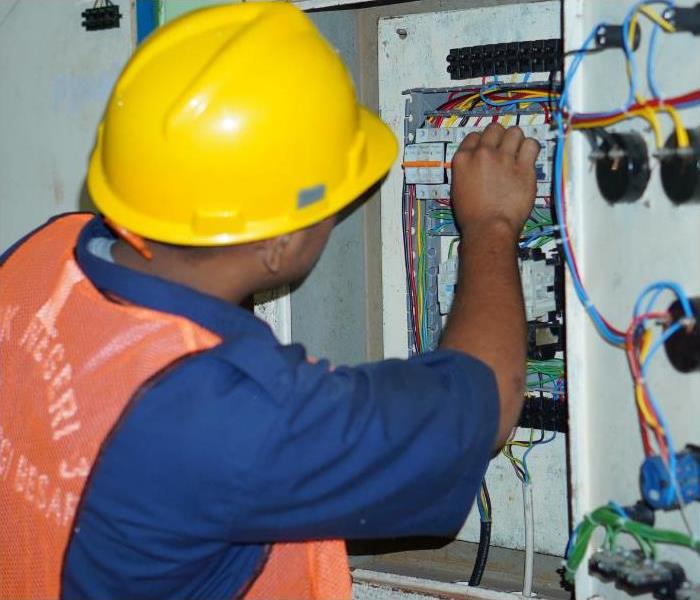 Crucial Fire Safety Tips for Homes in Layton, UT
Crucial Fire Safety Tips for Homes in Layton, UT
Fire safety is a critical concern for homeowners in Layton, UT, and across the country. Every year, thousands of homes are damaged or destroyed by fires that could have been prevented with proper precautions. In this comprehensive guide, we'll explore essential fire safety tips tailored specifically for residential homes in Layton, UT. By following these guidelines, you can significantly reduce the risk of fire and protect your home and loved ones.
1. Install and Maintain Smoke Alarms
Smoke alarms are your first line of defense against fires. Install smoke alarms on every level of your home, including inside each bedroom and outside sleeping areas. Test them monthly to ensure they are working properly, and replace batteries at least once a year. In Layton, UT, where winters can be cold, check that smoke alarms are not affected by extreme temperatures or drafts.
2. Have a Fire Escape Plan
Develop a fire escape plan and practice it with your family regularly. Identify at least two ways to escape from every room, especially bedrooms. Choose a meeting place outside the home where everyone will gather after escaping. Make sure that windows and doors can be easily opened from the inside and that security bars have quick-release mechanisms.
3. Keep Fire Extinguishers Handy
Place fire extinguishers in key locations such as the kitchen, garage, and workshop. Ensure that everyone in the household knows how to use them. The acronym PASS is a useful guide: Pull the pin, Aim the nozzle at the base of the fire, Squeeze the handle, and Sweep from side to side.
4. Practice Kitchen Safety
The kitchen is a common area where fires start. Never leave cooking unattended, especially when frying, broiling, or grilling. Keep flammable items like towels, paper towels, and curtains away from cooking appliances. If a grease fire occurs, carefully slide a lid over the pan and turn off the burner. Do not attempt to extinguish a grease fire with water.
5. Maintain Heating Equipment
If you use space heaters, keep them at least three feet away from anything that can burn, such as curtains, bedding, and furniture. Turn off space heaters when leaving the room or going to bed. Ensure that chimneys and vents are cleaned and inspected annually by a professional to prevent chimney fires and carbon monoxide buildup.
6. Practice Electrical Safety
Inspect electrical cords for fraying, damage, or signs of overheating. Avoid overloading outlets and extension cords, and never run cords under rugs or furniture. Consider installing AFCI (Arc-Fault Circuit Interrupter) outlets, which detect and mitigate electrical arcing to reduce the risk of electrical fires.
7. Store Flammable Materials Safely
Keep flammable liquids, such as gasoline, propane, and paint thinner, in tightly sealed containers in a well-ventilated area away from heat sources. Store them outside the home if possible, in a detached garage or shed. Never smoke near flammable materials or use them near open flames or sparks.
8. Install Fire-Resistant Materials
Consider using fire-resistant building materials when renovating or building your home. This includes fire-resistant roofing materials, siding, and insulation. Ensure that attic vents are equipped with spark arrestors to prevent embers from entering and igniting combustible materials.
9. Be Mindful of Smoking Hazards
If you smoke, do so outside and use deep, sturdy ashtrays. Never smoke in bed or when drowsy, and ensure that cigarette butts are fully extinguished before disposal. Consider quitting smoking altogether to eliminate this fire risk.
10. Educate Your Family and Guests
Educate your family members, especially children, about fire safety and the importance of fire prevention measures. Inform guests about your fire escape plan and designated meeting place. Encourage everyone in your household to be vigilant and proactive in fire safety practices.
By implementing these fire safety tips tailored for residential homes in Layton, UT, you can significantly reduce the risk of fire and protect your home and loved ones. Remember, fire safety is a collective responsibility that requires ongoing awareness and proactive measures. Stay informed, stay prepared, and prioritize safety in every aspect of your home life.
Rebounding After the Storm: How SERVPRO ® Can Help with Storm Damage Remediation and Cleanup in Layton, UT
7/3/2024 (Permalink)
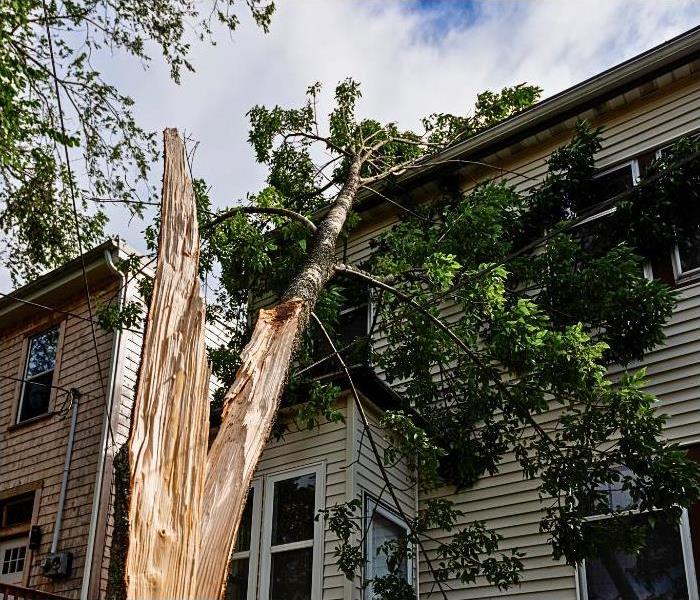 Storm Damage Remediation and Cleanup in Layton, UT
Storm Damage Remediation and Cleanup in Layton, UT
When a severe storm hits, the aftermath can be overwhelming. The strong winds, heavy rains, and lightning strikes typical of Utah’s storm season can leave your home or business in disarray. Storm damage isn't just an inconvenience; it poses significant risks to your property and health. In Layton, UT, SERVPRO® stands out as a trusted partner in storm damage remediation and cleanup. With their expertise, advanced technology, and compassionate approach, SERVPRO ® ensures that you can bounce back from any storm-related disaster swiftly and efficiently.
The Impact of Storm Damage
Storms can cause a range of damage, from minor leaks to major structural problems. Common issues include:
Water Damage: Heavy rains can lead to flooding, which can seep into basements, walls, and floors. This water can cause immediate damage and long-term issues like mold growth.
Wind Damage: Strong winds can tear off roofs, break windows, and uproot trees, causing extensive damage to the exterior and interior of buildings.
Structural Damage: Lightning strikes or fallen trees can cause severe structural damage, making homes and businesses unsafe.
Mold Growth: Water intrusion creates the perfect environment for mold to thrive, posing health risks and further damaging your property.
SERVPRO ®’s Comprehensive Approach to Storm Damage
SERVPRO ® of Layton, UT, provides a comprehensive suite of services designed to address every aspect of storm damage. Their team of professionals is equipped to handle the complexities of storm damage remediation with a structured and thorough approach.
1. Emergency Response
In the wake of a storm, time is of the essence. SERVPRO ® offers 24/7 emergency response services to address the immediate needs of storm damage. Their rapid response team arrives quickly to assess the situation and begin the remediation process, minimizing further damage.
2. Assessment and Inspection
Upon arrival, SERVPRO ® conducts a detailed inspection of the property to understand the extent of the damage. This involves identifying water damage, structural issues, and potential mold growth. This comprehensive assessment is crucial in developing an effective remediation plan.
3. Water Extraction and Drying
One of the most critical steps in storm damage remediation is removing water from the property. SERVPRO ® uses state-of-the-art water extraction equipment to remove standing water. Following extraction, industrial-grade dehumidifiers and air movers are deployed to dry out the affected areas, preventing mold growth and further water damage.
4. Mold Mitigation
If water damage has led to mold growth, SERVPRO ®’s experts are equipped to handle it. They use advanced mold remediation techniques to identify and eliminate mold, ensuring that it doesn’t spread to other areas of the property. This process includes air filtration to remove mold spores from the air and thorough cleaning of affected surfaces.
5. Structural Repairs and Reconstruction
Storms can cause significant structural damage, from damaged roofs to broken windows. SERVPRO ® provides a full range of construction services to repair and rebuild your property. Their team can handle everything from minor repairs to major reconstruction projects, ensuring your property is restored to its pre-storm condition.
6. Cleaning and Sanitizing
SERVPRO ® ensures that your home or business is thoroughly cleaned and sanitized. They use specialized cleaning techniques and products to remove dirt, debris, and contaminants brought in by the storm. This includes cleaning carpets, upholstery, and other surfaces to restore them to their original condition.
7. Insurance Claim Assistance
Navigating insurance claims after a storm can be daunting. SERVPRO ® works closely with insurance companies to simplify the claims process for their clients. They provide detailed documentation of the damage and the remediation work done, helping you get the compensation you need for repairs.
Why Choose SERVPRO ® of Layton, UT?
Choosing SERVPRO ® for storm damage remediation comes with several advantages:
Experience and Expertise: With years of experience in the industry, SERVPRO ® has honed its skills in handling storm damage of all kinds. Their team is highly trained and certified in disaster recovery and restoration.
Advanced Technology: SERVPRO ® utilizes the latest technology and equipment in the remediation and cleanup process. This ensures that the job is done efficiently and effectively, reducing the risk of further damage.
Comprehensive Services: From emergency response to reconstruction, SERVPRO ® offers a full range of services under one roof. This means you don’t have to coordinate with multiple contractors, simplifying the recovery process.
Customer-Centric Approach: SERVPRO ® understands the emotional toll that storm damage can take. They approach each project with compassion and professionalism, keeping clients informed and involved throughout the process.
Local Presence: As a locally owned and operated franchise, SERVPRO® of Layton, UT, has a deep understanding of the specific challenges faced by the community. They are committed to helping their neighbors recover and rebuild.
Steps to Take After a Storm
While SERVPRO ® provides professional remediation and cleanup services, there are steps you can take immediately after a storm to ensure your safety and start the recovery process:
Ensure Safety: Before anything else, make sure that you and your family are safe. Avoid entering severely damaged buildings and be cautious of potential hazards like downed power lines.
Document Damage: Take photos and videos of the damage to your property. This documentation will be helpful when filing insurance claims.
Contact SERVPRO ®: Reach out to SERVPRO ® of Layton, UT, as soon as possible. Their emergency response team will quickly mobilize to start the remediation process.
Notify Insurance: Inform your insurance company about the damage and begin the claims process. SERVPRO ® can assist you with the necessary documentation and communication with your insurer.
Storms are a powerful force of nature, but with the right support, you can recover and rebuild. SERVPRO ® of Layton, UT, is dedicated to helping the community restore their homes and businesses after a storm. Their comprehensive, compassionate, and expert approach ensures that storm damage is addressed promptly and effectively, allowing you to regain peace of mind and return to normalcy. Whether you're facing minor water damage or significant structural repairs, SERVPRO ® is the partner you can trust to navigate the storm’s aftermath.
Safeguarding Layton, UT: 10 Essential Tips to Reduce Flooding Risks
5/18/2024 (Permalink)
 Reduce Flood Risks in Layton, UT
Reduce Flood Risks in Layton, UT
Nestled in the picturesque valleys of Utah, Layton boasts stunning landscapes and a vibrant community. However, like many regions, Layton is not immune to the threat of flooding, particularly during the rainy seasons or snowmelt periods. The consequences of flooding can be devastating, causing property damage, disrupting lives, and posing risks to public safety. Fortunately, there are proactive measures residents can take to mitigate flooding risks and safeguard their homes and neighborhoods. In this blog, we'll explore ten essential tips to reduce flooding risks in Layton, UT.
1. Stay Informed:
Knowledge is power when it comes to flood preparedness. Stay informed about the local weather forecasts, flood warnings, and emergency evacuation plans. Sign up for alerts from local authorities and monitor news updates during heavy rainfall or snowmelt periods. Understanding the potential risks and being prepared to act swiftly can make a significant difference in minimizing flood damage.
2. Maintain Gutters and Drains:
Clogged gutters and storm drains can exacerbate flooding by preventing proper water drainage. Regularly inspect and clean gutters, downspouts, and drains to ensure they are free from debris such as leaves, twigs, and sediment. Consider installing gutter guards to prevent clogging and channel water away from your home's foundation.
3. Landscape with Flood-Resistant Plants:
Landscaping can play a crucial role in flood mitigation. Opt for flood-resistant plants and shrubs that can absorb excess water and help stabilize soil during heavy rainfall. Additionally, create natural slopes away from your home to direct water flow away from vulnerable areas. Avoid planting trees with invasive root systems near underground utilities to prevent potential damage.
4. Elevate Electrical Systems:
Electrical systems are particularly vulnerable to flooding and can pose serious safety hazards if submerged in water. Elevate electrical outlets, switches, and circuit breakers at least one foot above the base flood elevation level to minimize the risk of electrical fires and shocks. Consider hiring a licensed electrician to assess and implement necessary adjustments.
5. Install Sump Pumps:
Sump pumps are invaluable tools for preventing basement flooding by efficiently removing excess water from below-ground areas. Install a sump pump with a battery backup system to ensure continuous operation during power outages. Regularly test the pump and keep it well-maintained to ensure optimal performance when needed.
6. Waterproof Basements and Foundations:
Waterproofing your basement and foundation can provide an additional layer of defense against flooding. Seal cracks in the foundation walls and floors using waterproofing compounds or hydraulic cement. Install a waterproof membrane or coating on exterior foundation walls to prevent water infiltration. Consider landscaping techniques such as grading and installing French drains to divert water away from the foundation.
7. Elevate Furnaces and Appliances:
Like electrical systems, furnaces, water heaters, and other appliances located in basements or low-lying areas are susceptible to flood damage. Elevate these appliances on sturdy platforms or pedestals above the potential flood level to minimize the risk of water intrusion. Consult with HVAC professionals to ensure proper elevation and safe operation.
8. Secure Valuables and Important Documents:
In the event of a flood, valuable possessions and important documents can be irreparably damaged. Take proactive measures to safeguard these items by storing them in waterproof containers or safes placed above potential flood levels. Consider digitizing important documents and storing backups in secure cloud storage for added protection.
9. Retrofit Buildings for Flood Protection:
For properties located in high-risk flood zones, retrofitting measures can significantly reduce vulnerability to flooding. Consider installing flood barriers, flood vents, and backflow prevention devices to prevent water intrusion through doors, windows, and sewer systems. Consult with a qualified contractor or engineer to assess retrofitting options tailored to your property's specific needs.
10. Purchase Flood Insurance:
Despite best efforts to prevent flooding, the risk can never be completely eliminated. Protect your home and belongings by purchasing flood insurance through the National Flood Insurance Program (NFIP) or private insurers. Flood insurance can provide financial assistance to repair or replace damaged property and belongings in the event of a flood-related disaster.
Reducing flooding risks in Layton, UT, requires a combination of proactive measures, community cooperation, and preparedness. By staying informed, maintaining infrastructure, implementing flood-resistant practices, and investing in protective measures, residents can minimize the impact of flooding on their homes and neighborhoods. Remember, flood preparedness is a shared responsibility that benefits the entire community, ensuring a safer and more resilient future for Layton.
Fresh Start: Top Tips for Spring Cleaning in Layton, Utah
4/8/2024 (Permalink)
 Spring Cleaning in Layton, Utah
Spring Cleaning in Layton, Utah
As winter bids adieu and spring knocks on the door, it's time to embrace the tradition of spring cleaning. Layton, Utah, with its picturesque landscapes and vibrant community, provides the perfect backdrop for refreshing your home and welcoming the new season with open arms. Whether you're a seasoned spring cleaner or a newcomer to the tradition, these top tips will guide you through the process of revitalizing your space and rejuvenating your surroundings in Layton.
Create a Plan:
Before diving into the cleaning frenzy, take a moment to map out a plan. Assess each area of your home, identifying trouble spots and prioritizing tasks. Break down the cleaning process into manageable chunks, scheduling specific days or weekends for different areas. By creating a structured plan, you'll stay organized and avoid feeling overwhelmed by the enormity of the task ahead.
Declutter Mindfully:
Spring cleaning is not just about scrubbing floors and wiping windows; it's also an opportunity to declutter and simplify your living space. Take a discerning look at your belongings and ask yourself whether each item serves a purpose or brings you joy. Donate or recycle items that no longer serve you, and find creative storage solutions for those you wish to keep. In Layton, consider donating gently used items to local charities or thrift stores to support the community.
Embrace Green Cleaning:
As you embark on your spring cleaning journey, consider adopting eco-friendly cleaning practices. Opt for natural cleaning solutions such as vinegar, baking soda, and lemon juice, which are effective and safe for both your family and the environment. In Layton, you can find a variety of eco-friendly cleaning products at local stores or even make your own at home. Not only will you reduce your carbon footprint, but you'll also create a healthier indoor environment for you and your loved ones.
Focus on Outdoor Spaces:
In Layton, where the natural beauty of the outdoors beckons, don't forget to pay attention to your outdoor spaces during spring cleaning. Sweep away debris from pathways and driveways, prune overgrown shrubs and bushes, and give your lawn some much-needed TLC. Consider planting native flowers or vegetables in your garden to add a splash of color and contribute to local biodiversity. By sprucing up your outdoor spaces, you'll create inviting areas to relax and enjoy the sunshine in the upcoming months.
Tackle HVAC Maintenance:
As the temperatures start to rise in Layton, it's essential to ensure that your HVAC system is in top-notch condition. Change air filters, clean air vents, and schedule a professional HVAC inspection to address any potential issues before the summer heat sets in. A well-maintained HVAC system not only improves indoor air quality but also enhances energy efficiency, saving you money on utility bills in the long run.
Refresh Your Decor:
Spring cleaning is the perfect excuse to breathe new life into your home decor. Swap out heavy winter curtains for lightweight drapes that allow natural light to flood in. Incorporate cheerful accent pillows, throws, and rugs in vibrant colors and patterns to reflect the spirit of spring. Consider rearranging furniture to create a more spacious and inviting layout that encourages relaxation and socializing. In Layton, you can find inspiration for your home decor at local shops and boutiques, supporting small businesses in the process.
Don't Forget the Details:
While tackling major cleaning tasks, don't overlook the often-neglected details that can make a big difference in the overall cleanliness of your home. Dust ceiling fan blades, wipe down baseboards, and clean light fixtures to eliminate built-up grime and dust. Pay special attention to high-touch surfaces such as doorknobs, handles, and countertops, disinfecting them regularly to prevent the spread of germs and viruses. By attending to these small but significant details, you'll achieve a truly thorough spring cleaning in Layton.
Spring cleaning in Layton, Utah, is more than just a chore; it's a time-honored tradition that allows you to refresh your home and embrace the beauty of the season. By following these top tips, you'll embark on a journey of renewal, creating a clean, organized, and inviting space to enjoy with family and friends. So roll up your sleeves, put on your favorite cleaning playlist, and let the spirit of spring guide you as you breathe new life into your home in Layton.
What is Mold and How to Prevent It in Your Layton, UT Home
3/11/2024 (Permalink)
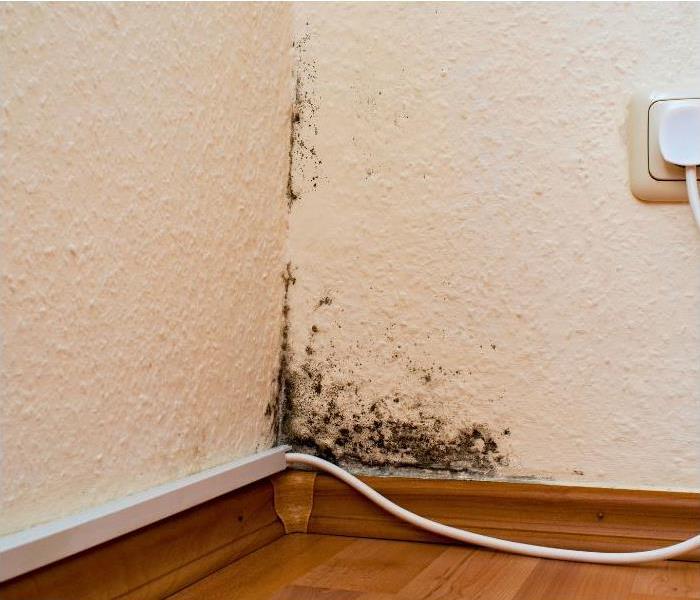 Prevent mold in Layton , UT
Prevent mold in Layton , UT
Mold is an unwelcome guest that can silently invade our homes, posing potential health risks and damaging the structure of the property. Layton, UT, with its diverse climate, is not immune to mold growth. Understanding what mold is, its potential dangers, and how to prevent it is crucial for homeowners in Layton and beyond. In this blog post, we will delve into the world of mold, its causes, and effective preventive measures tailored to the Layton, UT, environment.
What is Mold?
Mold is a type of fungus that thrives in damp and humid conditions. It reproduces through tiny spores that are invisible to the naked eye, floating in the air until they find a suitable surface to settle on. Once established, mold can grow rapidly, forming colonies and releasing mycotoxins that can be harmful to human health. The most common types of household molds include Aspergillus, Cladosporium, Penicillium, and the notorious Stachybotrys chartarum, also known as black mold.
Causes of Mold Growth
Understanding the factors that contribute to mold growth is essential for effective prevention. In Layton, UT, several elements can create an environment conducive to mold formation:
Humidity:
Layton experiences varying humidity levels throughout the year. High humidity, especially in the warmer months, can create conditions ideal for mold growth. Controlling indoor humidity is crucial in preventing mold.
Water Leaks:
Leaky roofs, pipes, or windows provide the moisture mold needs to thrive. Layton residents should regularly inspect their homes for potential leaks, especially after heavy rain or snowfall.
Inadequate Ventilation:
Poor ventilation can trap moisture indoors, fostering an environment suitable for mold. Proper ventilation in bathrooms, kitchens, and basements is vital to prevent stagnant air and excess humidity.
Flooding:
Layton, UT, occasionally experiences heavy rainfall and snowmelt. Flooding can result in water damage and create an environment conducive to mold growth. Promptly addressing and properly drying affected areas is crucial.
Condensation:
Cold surfaces in homes, such as windows and walls, can lead to condensation when warm, moist air comes into contact with them. This condensation provides a breeding ground for mold. Adequate insulation and temperature control can mitigate this risk.
Preventing Mold Growth in Layton, UT
Now that we understand the causes and potential dangers of mold, let's explore practical steps to prevent its growth in Layton homes:
Monitor and Control Humidity:
Use dehumidifiers to maintain indoor humidity levels below 60%. In Layton's climate, this is especially important during warmer months. Proper ventilation and air circulation also help prevent excessive humidity.
Regular Inspections:
Conduct routine inspections of your home, checking for leaks in the roof, walls, and plumbing. Promptly address any water damage to prevent mold from taking hold.
Effective Ventilation:
Ensure proper ventilation in high-moisture areas like bathrooms, kitchens, and basements. Install exhaust fans and open windows to promote air circulation and prevent stagnant air.
Proper Insulation:
Adequately insulate walls, floors, and windows to prevent condensation on cold surfaces. This helps control moisture and discourages mold growth.
Quick Response to Water Damage:
Act promptly in the event of water damage, whether from a leak or flooding. Thoroughly dry and clean affected areas within 24-48 hours to prevent mold colonization.
Regular Cleaning:
Regularly clean and dust your home to minimize the presence of mold spores. Pay attention to areas prone to moisture, such as bathrooms and kitchens.
Use Mold-Resistant Products:
When renovating or building, consider using mold-resistant materials in areas prone to dampness. These materials are designed to resist mold growth, providing an additional layer of protection.
Proper Landscaping:
Ensure that the landscaping around your home encourages water drainage away from the foundation. Proper grading and gutter maintenance can prevent water accumulation near your property.
Mold prevention is a crucial aspect of maintaining a healthy home environment, especially in regions like Layton, UT, where climate conditions can vary. By understanding the causes of mold growth and implementing practical preventive measures, homeowners can create an inhospitable environment for mold, safeguarding their property and the well-being of its occupants. Regular inspections, effective ventilation, and prompt responses to water damage are key components of a successful mold prevention strategy. Taking these steps will not only protect your home but also contribute to a safer and healthier living environment for you and your family in Layton, UT.
Restoring Tranquility: How SERVPRO of Layton Rescues Homes from Water Damage
1/15/2024 (Permalink)
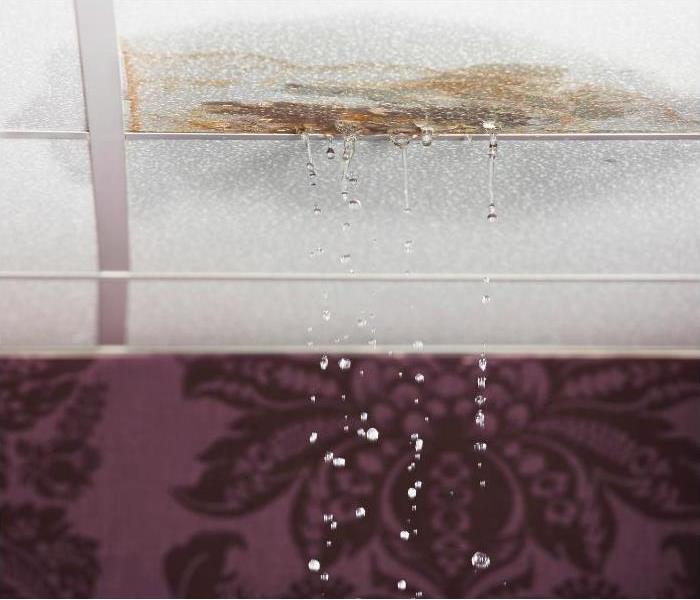 Water Damage in Layton, Ut.
Water Damage in Layton, Ut.
Water damage is an unwelcome guest that can wreak havoc on your home, turning a peaceful haven into a chaotic disaster. Whether it's a burst pipe, a leaky roof, or a malfunctioning appliance, water damage demands swift action to prevent further destruction. In such dire situations, the expertise and prompt response of professionals like SERVPRO of Layton become invaluable. In this blog, we will explore the common causes of water damage, the potential consequences for your home, and how SERVPRO of Layton can work miracles in restoring your dwelling to its pre-damage state.
1. The Causes of Water Damage
Water damage can stem from various sources, each presenting its unique challenges. Leaking pipes are among the most common culprits. Over time, pipes can corrode, weaken, or develop small cracks, leading to slow leaks that often go unnoticed until significant damage has occurred. Additionally, extreme weather conditions, such as heavy rain or snowmelt, can expose vulnerabilities in your home's structure, allowing water to seep through roofs and foundations.
Appliances are another frequent source of water damage. Malfunctioning dishwashers, washing machines, or refrigerators can release water into your home, causing damage to floors, walls, and personal belongings. Moreover, blocked or overflowing gutters and downspouts can lead to water pooling around your home's foundation, resulting in basement flooding and structural damage.
2. The Consequences of Water Damage
The aftermath of water damage can be devastating, affecting both the structure of your home and your personal belongings. If left untreated, water damage can lead to mold growth, compromising the air quality and posing health risks to inhabitants. Wood and drywall can warp, paint can peel, and structural integrity can be compromised, leading to costly repairs. Beyond the physical damage, the emotional toll of seeing your cherished possessions ruined can be overwhelming.
Swift Action: The Key to Mitigating Water Damage
When faced with water damage, time is of the essence. Taking prompt action can significantly reduce the extent of the damage and the associated costs. Here are some immediate steps you can take:
Turn off the Water: If the water damage is caused by a burst pipe or malfunctioning appliance, locate and shut off the main water supply to prevent further flooding.
Document the Damage: Take photos or videos of the affected areas to document the extent of the damage. This documentation can be crucial when filing insurance claims.
Remove Standing Water: Use mops, towels, or a wet/dry vacuum to remove as much standing water as possible.
Ventilate the Area: Open windows and doors to facilitate air circulation and promote drying.
Contact Professionals: Reach out to water damage restoration experts like SERVPRO of Layton for immediate assistance.
SERVPRO of Layton: Your Trusted Restoration Partner
When water damage strikes, SERVPRO of Layton is your ally in restoring tranquility to your home. With a team of highly trained professionals and state-of-the-art equipment, SERVPRO specializes in mitigating water damage and restoring properties to their preloss condition.
Rapid Response: SERVPRO of Layton understands the urgency of water damage situations. Their 24/7 emergency services ensure that a team is ready to respond promptly to your call, minimizing further damage.
Assessment and Planning: Upon arrival, SERVPRO experts conduct a thorough assessment of the damage. This includes identifying the source of the water, evaluating affected areas, and formulating a comprehensive restoration plan tailored to your specific needs.
Water Extraction: Utilizing advanced extraction equipment, SERVPRO swiftly removes standing water from your home. This step is crucial in preventing secondary damage and mold growth.
Drying and Dehumidification: SERVPRO employs industrial-strength air movers and dehumidifiers to thoroughly dry affected areas. This helps prevent long-term damage and inhibits the growth of mold and mildew.
Cleaning and Sanitizing: Once the drying process is complete, SERVPRO's skilled technicians clean and sanitize the affected areas. This includes the removal of contaminants and odors, ensuring a safe and healthy environment.
Restoration and Reconstruction: SERVPRO of Layton doesn't just stop at water removal and drying; they offer comprehensive restoration services. This may include repairing or replacing damaged drywall, flooring, and other structural elements to return your home to its pre-damage state.
Dealing with water damage is a stressful experience, but with the right professionals by your side, the restoration process can be swift and effective. SERVPRO of Layton stands out as a reliable partner, offering a seamless journey from the initial assessment to the final restoration, making your home feel "Like it never even happened." Don't let water damage disrupt your peace of mind—trust SERVPRO of Layton to restore your home and bring back the tranquility you deserve.
Mastering the Cold: Dealing with Frozen Pipes
12/28/2023 (Permalink)
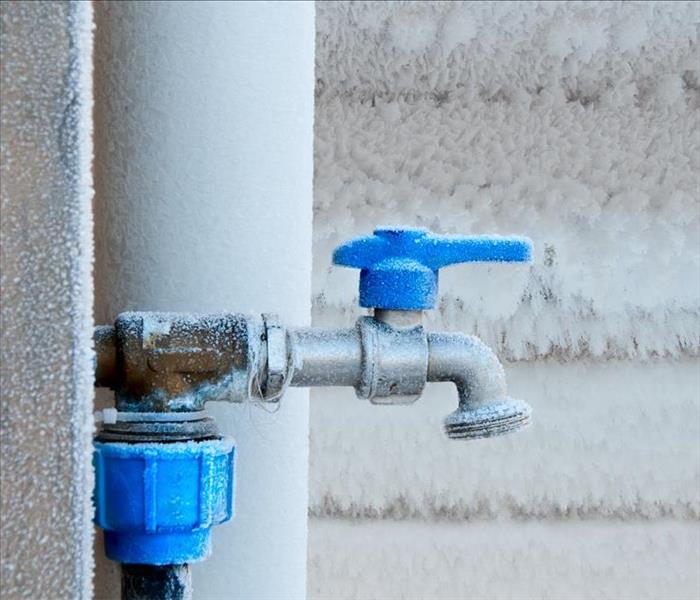 A frozen faucet in Layton, UT.
A frozen faucet in Layton, UT.
Winter in Layton, UT, paints a picturesque scene with snow-covered landscapes and crisp, chilly air. However, alongside the beauty of the season comes the risk of frozen pipes, a common woe for homeowners in colder climates. As temperatures plummet, pipes can freeze, leading to potential water damage and plumbing headaches. In this comprehensive guide, we'll explore the causes of frozen pipes, preventive measures, and effective solutions to ensure your home stays warm and watertight throughout the winter.
Understanding the Problem:
Before diving into solutions, it's crucial to understand the science behind frozen pipes. Layton, like many areas in Utah, experiences freezing temperatures during winter. When water in pipes reaches the freezing point, it expands, creating pressure within the pipes. This pressure can lead to cracks or even burst pipes, resulting in water damage to your home.
Common Causes of Frozen Pipes:
Insufficient Insulation:
Exposed pipes in unheated areas, such as basements, attics, or crawl spaces, are vulnerable to freezing.
Lack of insulation or inadequate insulation allows the cold to penetrate the pipes, putting them at risk.
Sudden Drops in Temperature:
Drastic temperature fluctuations, especially when temperatures plummet overnight, can catch pipes off guard, leading to freezing.
Neglecting Outdoor Plumbing:
Outdoor faucets and hose bibs are susceptible to freezing if not properly insulated or shut off before winter.
Preventive Measures:
- Insulate Pipes:
Identify and insulate exposed pipes using pipe insulation or heating tape. Focus on areas prone to freezing, such as basements, attics, and crawl spaces.
- Maintain a Consistent Temperature:
Keep your home's temperature steady, even when you're away. A slight increase in the thermostat setting during extremely cold weather can make a significant difference in preventing pipe freeze.
- Seal Leaks and Cracks:
Inspect your home for drafts and seal any gaps in windows, doors, and walls. This not only helps prevent frozen pipes but also improves overall energy efficiency.
- Disconnect and Drain Outdoor Hoses:
Before the cold sets in, disconnect and drain outdoor hoses. Shut off water to outdoor faucets and install faucet covers for added protection.
Dealing with Frozen Pipes:
Despite your best efforts, frozen pipes may still occur. When faced with this challenge, follow these steps to thaw them safely:
- Identify the Frozen Section:
Determine which pipes are frozen by checking for areas with reduced or no water flow. Faucets that produce a slow trickle or no water at all may indicate a frozen pipe.
- Open Faucets:
Before attempting to thaw the pipes, open the affected faucets. This will relieve pressure and allow water to flow once the ice blockage begins to melt.
- Apply Heat: Use a gentle heat source to thaw the frozen pipes. Electric heating pads, hairdryers, or space heaters can be effective. Never use an open flame, as it poses a fire hazard.
- Work from the Faucet Outward:
Start applying heat near the faucet and work your way toward the frozen section. This helps melt the ice gradually and prevents pressure buildup.
- Inspect for Damage:
Once the pipes have thawed, check for any visible damage. Look for cracks, leaks, or signs of weakness. If you notice any issues, it's advisable to consult a professional plumber for repairs.
Dealing with frozen pipes in Layton, UT, requires a combination of preventive measures and effective thawing techniques. By taking proactive steps to safeguard your plumbing and knowing how to safely thaw frozen pipes, you can navigate the winter chill without the worry of plumbing disasters. Remember, a little preparation goes a long way in ensuring a warm and water-filled home during the coldest months of the year. Stay warm, stay informed, and enjoy a cozy winter in Layton!
Safety in the Kitchen: How to Extinguish a Grease Fire and Restore Your Layton, UT Home with SERVPRO of Layton
10/23/2023 (Permalink)
 Grease fires are very common in Layton, UT.
Grease fires are very common in Layton, UT.
The kitchen is often considered the heart of a home, where the delightful aroma of home-cooked meals wafts through the air. However, amidst the culinary delights, the kitchen can also be a potential fire hazard, especially when it comes to grease fires. In this comprehensive blog post, we'll dive deep into the world of grease fires and explore everything you need to know about preventing and extinguishing them in your Layton, UT home. Additionally, we'll shed light on how SERVPRO of Layton can be your guiding light in restoring your home if you ever face a fire-related emergency.
Understanding Grease Fires
Grease fires are among the most common kitchen fires and can turn dangerous in the blink of an eye. They occur when cooking oil or fat becomes too hot and ignites. Unlike other fires, grease fires have their unique characteristics that require specific actions for safe extinguishing.
Why Do Grease Fires Happen?
Grease fires primarily occur due to overheating. When the oil or fat in a pan or pot surpasses its smoke point and reaches its ignition temperature, a spark, or even a tiny droplet of water, can lead to a blazing inferno. Common reasons for grease fires include:
High Cooking Temperatures: Frying or deep-frying often requires high temperatures that can easily ignite the oil or fat.
Cooking Frozen Food: The introduction of frozen foods into hot oil can cause sputtering, leading to grease fires.
Oil Splatter: Any sudden movement or dropping of food into hot oil can cause oil to splatter, creating the potential for a fire.
Old or Contaminated Oil: Oil that has been reused multiple times or is contaminated with food particles is more likely to catch fire.
Identifying a Grease Fire
Grease fires are distinguishable by their distinct characteristics:
- Intense flames that may be accompanied by smoke.
- A popping or crackling sound.
- Fire localized in the pan or pot, but it can quickly escalate if not managed.
How to Extinguish a Grease Fire
If you ever find yourself facing a grease fire in your Layton, UT home, follow these steps to ensure your safety and the safety of your loved ones.
Don't Panic: Stay calm. Panic can lead to poor decision-making. Remember, you have the knowledge and tools to manage the situation.
Turn Off the Heat: If safe to do so, turn off the heat source. This step helps prevent the fire from growing further.
Cover with a Lid: If the fire is still relatively small and manageable, use a metal lid or a baking sheet to cover the pan. This action will smother the flames by cutting off the oxygen supply.
Avoid Water: Never use water to extinguish a grease fire. Water will only make it worse by splattering the hot oil and spreading the fire. Moreover, it can lead to steam burns.
Baking Soda: If available, carefully sprinkle baking soda over the fire. Baking soda is a fire suppressant and can help smother the flames.
Fire Extinguisher: Keep a Class K fire extinguisher in your kitchen, specifically designed for grease fires. If you're comfortable using one, follow the manufacturer's instructions to discharge it safely.
Call 911: If the fire becomes uncontrollable or starts spreading beyond the cooking area, don't hesitate to call 911 for professional assistance. Your safety should always be the top priority.
The Importance of Fire Safety
The adage "prevention is better than cure" holds particularly true when it comes to grease fires. Here are some practical tips to prevent grease fires in your kitchen:
Stay Vigilant: Never leave cooking unattended, especially when using high heat or oil.
Use a Thermometer: Invest in a cooking thermometer to monitor oil temperature when frying.
Keep a Lid Nearby: Always have a metal lid or a baking sheet close to your cooking area. You can use it to smother a potential fire if it occurs.
Keep the Area Clean: Regularly clean your stovetop and oven to remove any built-up grease or food particles that could catch fire.
Properly Dispose of Used Oil: Dispose of used cooking oil or fat safely and responsibly. Never pour it down the drain or throw it in the trash.
SERVPRO of Layton: Your Partner in Restoration
Extinguishing a grease fire is just the first step in the journey. Even after successfully putting out the fire, you may still have to deal with the aftermath, including smoke and fire damage to your home. This is where SERVPRO of Layton comes in as your trusted partner.
Our Expertise in Fire Damage Restoration
SERVPRO of Layton specializes in fire damage restoration, understanding the unique challenges posed by grease fires. Our highly trained professionals possess the expertise and equipment to restore your home to its pre-fire condition, ensuring you can get back to your daily routine as soon as possible.
Our Services Include:
Assessment: We assess the extent of the damage, taking into account not only the visible fire and smoke damage but also potential hidden issues.
Smoke and Soot Removal: SERVPRO uses advanced techniques to remove smoke and soot residues from surfaces, ensuring a clean and safe environment.
Odor Removal: Smoke leaves behind a persistent odor that can be challenging to eliminate. SERVPRO employs specialized equipment and techniques to effectively remove these odors.
Structural Restoration: Whether it's repairing damaged walls, ceilings, or flooring, SERVPRO has the expertise to restore your home to its pre-fire condition.
In conclusion, grease fires can be both terrifying and dangerous, but with the right knowledge and actions, you can protect your Layton, UT home. Safety is paramount when dealing with these fires. Remember to stay calm, follow the correct steps for extinguishing, and never hesitate to call 911 if the situation gets out of control.
SERVPRO of Layton is your dedicated partner in fire damage restoration, ensuring your home is returned to its former glory. Your kitchen is where wonderful memories are created, and it's our mission to make sure you can continue doing so in a safe and secure environment. Stay safe, and always be prepared!
How To Treat Mold
9/13/2023 (Permalink)
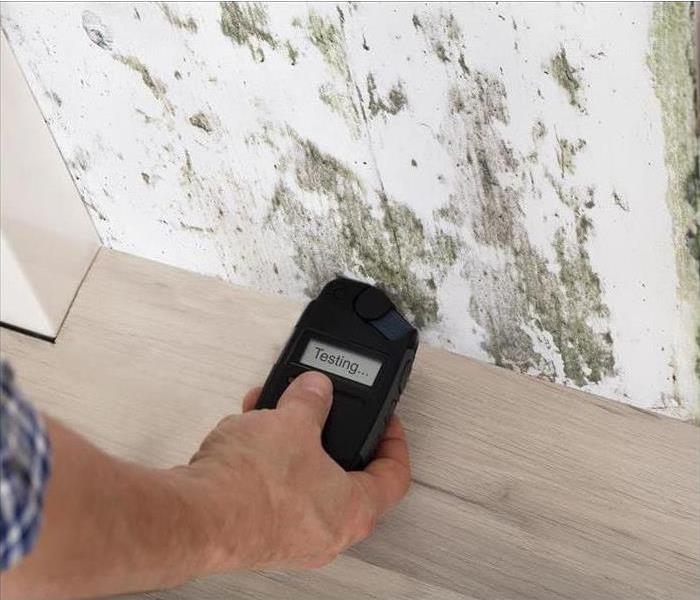 Mold testing in Layton, UT.
Mold testing in Layton, UT.
A musty odor in your commercial building in Layton, UT, is a clear sign of mold. What may not be clear is the visible presence of the fungus on your walls or ceiling. If you suspect you have mold but you can't see it, an indoor environmental specialist must test the building before remediation can take place.
6 Steps to Treat Mold
1. Detection
Some business owners try to locate problems themselves using a mold test from the local hardware store. The only thing this test will tell you, however, is that spores are present in the building, and that's always true. Any time the door opens, mold can enter on clothes, hair, and shoes. It doesn't become a problem until it concentrates and begins to grow on surfaces. Sometimes, you can't see the surfaces where it grows, though. Then you need a professional inspection.
2. Testing
A certified hygienist conducts tests on both surfaces and the air. These tests reveal more than just the presence of mold:
- Location of the greatest concentration of spores
- Type of mold present
- Air quality of the affected area
Once the testing is complete, the mold mitigation specialists know where to start.
3. Assessment
The report from the indoor environmental specialist is an essential part of the overall assessment process. It tells the remediation team members how large an area they need to seal off so that the mold problem doesn't spread any further in the building. From that point, they can create a plan of action for taking care of the issue. At this point, they should also be able to provide a general estimate to supplement your insurance claim.
4. Removal
One of the first things that technicians must do is tear out any unsalvageable material. If there is mold growth on any porous matter, such as drywall or industrial ceiling tiles, it cannot simply be washed away. The fungus on the surface isn't the only problem. When spores settle, tendrils called mycelia to reach down into the spaces beneath the surface to anchor the growth. Once this happens, the only way to get rid of it is to take the affected materials out altogether.
5. Retesting
After the growth has been removed, the remaining surfaces are cleaned and dried to prevent the problem from returning. Then the area must be retested. This crucial step of the process ensures that the actions taken by the mitigation team are effective and that no mold issue persists. Remediation must be completed before the structure can be rebuilt.
6. Restoration
The final phase is getting the building back to normal. New tiles and drywall are installed. Paint and wallpaper are matched to the existing space so that no one can tell where the problem occurred. The job isn't done until your building looks like there was never a problem at all.
If you suspect that you have mold in your building but you don't see any visible evidence, you should call an indoor environmental specialist. A professional test reveals what kind of problem you have and how big it is. This is exactly the information the mitigation team needs in order to do its job well.
Avoid a Candle Fire With Safe Habits and Alternatives to Open Flames
8/31/2023 (Permalink)
 Avoid a Candle Fire in your Layton, UT house by following these important tips.
Avoid a Candle Fire in your Layton, UT house by following these important tips.
The soft flicker of a flame is soothing and comfortable. For many homeowners, the gentle scents and appearance of candles provide a calming, peaceful atmosphere. Unfortunately, candle fire is also responsible for a lot of home damage:
Avoid Fire Damage by following these tips
At least 2% of home fires are caused by candles.
Just a few years ago, there was an average of 20 candle fires are reported each day, and today there are more than 10,000 each year. Fires due to candles peak during December and January.
These facts come from the National Fire Protection Association and their research division. Looking at these statistics, is it possible to safely use candles in your home?
Prevent a Candle Fire From Destroying Your Home
The good news is that today there are plenty of options for getting the same ambiance from candle fire without the risks associated with open flames. If you do plan to use the real thing, be sure to take the following precautions:
- Clear the area around the candle. Plants, decorations, linens, and other flammable items all pose fire hazards.
- Position candles where children, pets, and blowing curtains won't knock them over. Make sure candles are placed on a sturdy, level surface.
- Never leave candles unattended; many fires occur when homeowners fall asleep and more than a third of home candle fires started in bedrooms.
- Store candles, matches, and lighters where children can't reach them.
Habits for Proper Care of Candles
In addition to these foundational safety habits, there are several other things you can do to improve your well-being around candles. Trim candlewicks to about a quarter of an inch. If the wick is too short, the flame won't burn correctly. If the wick is too long, it will cause the flame to flare and flicker. Flares can lead to fires.
Take the heat of candles into account. Some candleholders (such as wine bottles) aren't sturdy or heat-resistant enough to withstand the burning heat. The rising temperature can cause glass holders to crack, spilling out wax and potentially causing a candle fire. It's also important that you place candles at least 3 to 4 inches apart and avoid handling candles before they cool.
Alternatives to Open Flames
Many fire safety authorities (as well as fire damage cleanup and restoration professionals) recommend using alternatives to candles. One of the most popular of these is the flameless candle. These are available in many sizes, shapes, and colors. Some are remote-operated, and many use an LED bulb that mimics the flicker of a candle flame. You can even find these candles with a warm vanilla scent. Some of the other options to consider include reed diffusers, wax warmers, humidifiers with essential oils, and strings of fairy lights.
The best way to avoid fire and smoke damage, as well as the cost of fire and smoke cleanup, is to take preventative steps and improve fire safety in your Layton, UT, home. This includes the installation of fire extinguishers and fire and smoke alarms. Develop the appropriate habits for enjoying an open flame and learn to properly maintain your candles. Best of all, consider an alternative. Don't let your peaceful evening end with destructive candle fire.





 24/7 Emergency Service
24/7 Emergency Service









